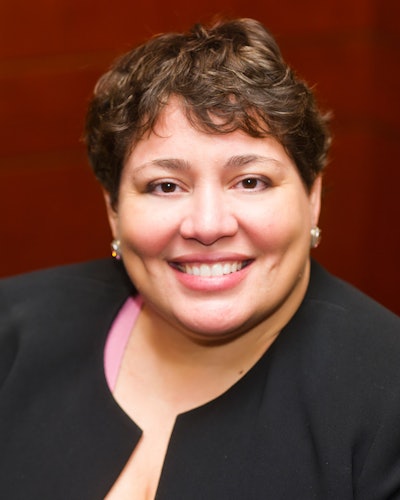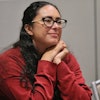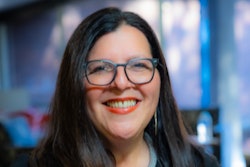In the first of what Dr. Deborah Santiago hopes might become a series of conversations, Excelencia in Education brought together a group of Latinx scholars to discuss the state of higher education on the island of Puerto Rico.
 Dr. Deborah Santiago
Dr. Deborah Santiago
“Too often we find there’s a great deal of ignorance about the island,” said Santiago, CEO and co-founder of the organization committed to Latino success in higher education.
Roughly 200,000 students attend one of Puerto Rico’s 85 higher education institutions. Although the cost of attending college on the island has increased in the last twenty years, the full-time retention rate for Latinx students has improved, from 65% in 2003, to 70% in 2019. In fact, Latinx students were retained at a higher rate than on the U.S. mainland (64%). Private institutions, which make up the majority of institutions on the island, have seen increasing graduation numbers, while public institutions have remained stagnant.
Understanding what’s happening on the island, said Santiago, is crucial to understanding “the broader Latinx community in the country. You can’t have a complete view of Latinos without paying attention to Puerto Rico.”
In 2017, Puerto Rico survived the deadly strike of Hurricane Maria and the ensuing bankruptcy of its government. Total population on the island has shrunk by roughly half a million people since 2010, impacting K-12 populations in particular as residents now skew older. In an attempt to restructure the weakened government budget, one third of the island’s K-12 schools were closed in a span of three years.
Closing those schools meant a “decline in academic achievement in standardized tests,” said Dr. José Caraballo-Cueto, an assistant professor and researcher at University of Puerto Rico (UPR) in Cayey and a 2019 Diverse Emerging Scholar.
“We compared before and after,” he said. “You [now] have a cohort of students on the island that, when they go to college, they will be less prepared.”
To address population declines, Caraballo-Cueto encouraged universities and colleges on the island to look at ways to attract more students from abroad, “especially from Latin America, to substitute the students you used to have,” he said.
“If the economy drops once again, we can expect the out-migration to increase,” he added.
Dr. Hilda Colon Plumey, professional educational consult and a former vice president of the Ana G. Mendez University System in San Juan, Puerto Rico, said that the universities on the island have, in general, “been remarkably efficient at overcoming financial challenges posed internally and externally.”
“The public system usually had a high dependency on the government funds it received yearly,” said Plumey. When the bankruptcy resulted in the slashing of over 50% of the budget at UPR, college officials had to adjust their costs and admissions process to make up for the loss.
“The public university system, the whole encompassing set of institutions that depend on the government of Puerto Rico, they have suffered tremendously,” said Plumey. “The fact that they are still working means that they have found ways to try to survive.”
That resiliency is something that Dr. Margarita Benítez, executive director of Fundación Puertorriqueña de las Humanidades, wants to see Puerto Rican universities share with their fellow institutions on the mainland.
“Let’s look at what you do after a hurricane,” she said. “A number of institutions have had that experience. So have we.”
She said that Puerto Rican institutions know not only what it’s like to experience the chaos and devastation of a hurricane, but can share best practices when it comes to recovering.
“There’s nothing more frustrating than to wanting to be helpful but be unable to assist, partially because the institution doesn’t know what it needs,” she said.
Benítez, who was born and raised on Puerto Rico but went mainland to earn her master’s and doctoral degrees, said the issue of trust between institutions became a weakness during Hurricane Maria.
“We must strengthen collaboration between mainland and Puerto Rican institutions,” she said.
 Dr. José Caraballo-Cueto
Dr. José Caraballo-Cueto
“Puerto Rico,” said Benítez, “has no greater friend than the Puerto Rican diaspora. Their loyalty and trust I have experienced time and again, in Spanish or English, and those are real allies.”
But the challenges of becoming a minoritized person on the mainland are real.
“To be a minority in the U.S., as we know, is an experience that’s hard to live if you haven’t lived it,” she said, adding that she would like to see more island institutions directly connecting with their diaspora to “ease the way.”
Caraballo-Cueto would like to see elementary and secondary education in Puerto Rico find more ways to individualize a student’s education experience.
“Almost 13% of students in Puerto Rico have specific learning problem,” he said. “If we don’t address these learning problems, the probability that they drop out is higher.”
Plumey emphasized the importance of prioritizing student support. She said she saw a prime opportunity at the middle school level for institutions to create pathways for students.
“There’s where I think the biggest gap is,” she said. “We need to move those students into the pathway, the pipeline, toward university.”
Liann Herder can be reached at [email protected].
















